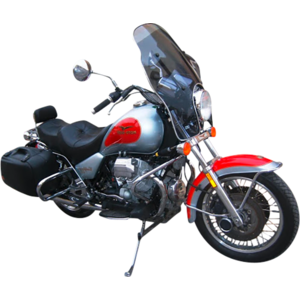Moto Guzzi California 1100 [1996-2013]: A Timeless Italian Cruiser with Soul
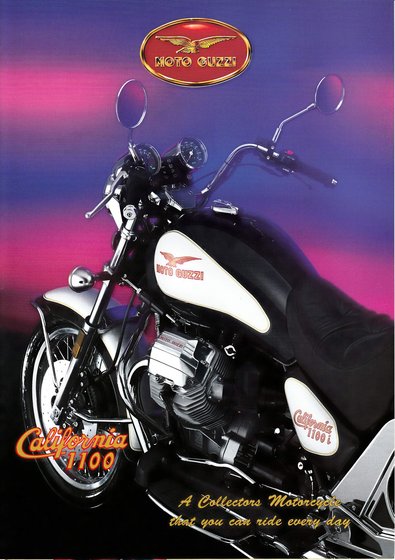
Introduction
The Moto Guzzi California 1100 isn’t just a motorcycle—it’s a statement. Produced from 1996 to 2013, this Italian cruiser defies the conventions of its era with a blend of old-world charm and engineering quirks that make it unforgettable. Whether you’re drawn to its longitudinal V-twin heartbeat, shaft-driven reliability, or its ability to turn heads at every café stop, the California 1100 occupies a unique niche in motorcycling history. After spending time with this machine, it’s clear why it developed a cult following—and why it still resonates with riders seeking character over conformity.
Design & Ergonomics: Classic Lines Meet Functional Imperfections
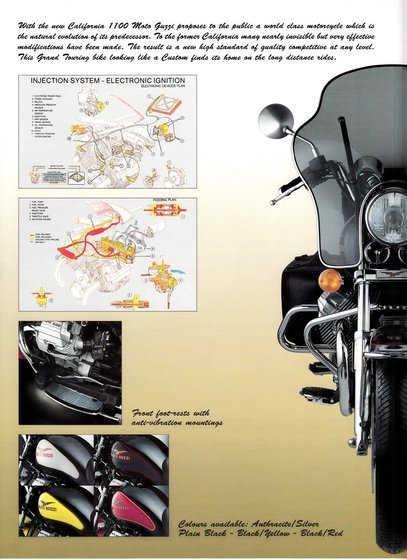
The California 1100’s design is unapologetically retro, with sweeping fenders, abundant chrome, and a teardrop fuel tank that harks back to the 1970s. The spoked wheels (on earlier models) and dual front disc brakes add a touch of rugged elegance, while the transverse V-twin engine dominates the bike’s profile like a mechanical sculpture.
Seat heights vary slightly across trims—from 720 mm (28.3 inches) on the base model to 780 mm (30.7 inches) on later editions—but the wide saddle and forward-mounted floorboards create a relaxed riding position. Taller riders might find the cylinder heads brushing against their knees at stops, a quirk that requires some acclimatization. The handlebars are comfortably positioned for a neutral lean, though the mirrors often vibrate enough to blur traffic behind you—a small price to pay for the Guzzi’s visceral charm.
Engine & Performance: Torque, Vibration, and Unmistakable Character
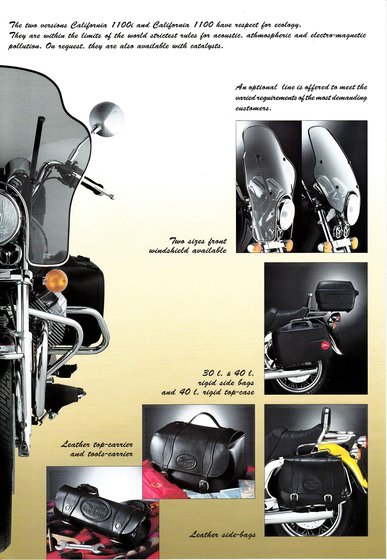
The Heartbeat of Mandello del Lario
At the core of the California 1100 lies its air-cooled, 1,064cc 90-degree V-twin. With 74–75 HP peaking at 6,400 RPM and 90–95 Nm of torque (66–70 lb-ft) arriving as early as 5,000 RPM, this engine prioritizes mid-range grunt over top-end frenzy. The power delivery is linear, pulling strongly from 1,500 RPM all the way to its 8,000 RPM redline. You’ll rarely need to rev it hard—the California thrives on lazy throttle inputs, chugging through city traffic or devouring highways with equal nonchalance.
Quirks and Charms
The Weber fuel injection (a rarity in mid-’90s cruisers) ensures crisp throttle response, though the engine’s lumpy idle at 1,000 RPM sends a constant buzz through the handlebars. The 5-speed gearbox, while robust, demands firm shifts—a trait that pairs oddly with the otherwise relaxed riding experience. Shaft drive eliminates chain maintenance but introduces mild “jacking” effects under acceleration, a small trade-off for its reliability on long tours.
Handling & Ride: A Study in Contradictions
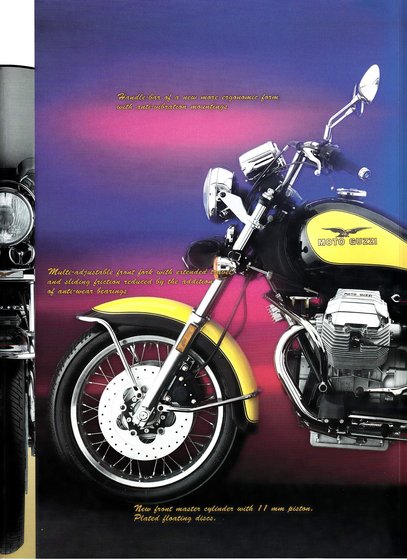
City Manners
At low speeds, the California feels surprisingly nimble for its 240–254 kg (529–560 lbs) dry weight. The steering is light, and the floorboards ground predictably in tight turns. The linked braking system—activating the left front and rear calipers with the lever, and the right front with the pedal—offers reassuring stopping power, though purists might miss individual control.
Open-Road Compromises
Push beyond 130 km/h (80 mph), and the California’s weight and soft suspension begin to show. The front forks dive under hard braking, and the rear shocks wallow over repeated bumps. Yet, the steering damper (a curious addition for a cruiser) keeps wobbles in check, while the 190 km/h (118 mph) top speed is more than adequate for cross-country jaunts. This isn’t a bike for knee-down cornering—it’s for savoring the journey, vibrations and all.
Competition: How the California Stacks Up
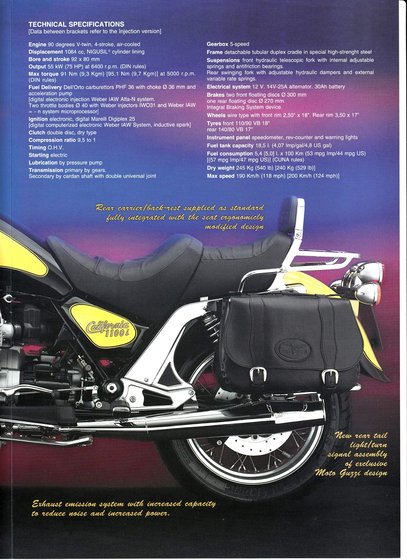
Harley-Davidson Dyna Glide
The Dyna Glide’s 1,440cc V-twin offers more low-end torque, but its chain drive and air-cooled engine lack the Guzzi’s refinement. Harley’s aftermarket support is superior, but the California counters with better fuel injection and a distinct European flair.
Honda Shadow 1100
Honda’s V-twin is smoother and quieter, but it lacks the Guzzi’s personality. The Shadow’s plastic-heavy design also feels dated next to the California’s chrome-and-metal craftsmanship.
BMW R1200C
BMW’s cruiser shares the Guzzi’s shaft drive and boxer-engine layout, but its focus on modernity (think ABS and adjustable ergonomics) sacrifices the raw, mechanical connection that defines the California.
Verdict: The California 1100 isn’t the fastest, smoothest, or most practical cruiser. But for riders craving authenticity, its transverse V-twin and Italian pedigree make it a standout.
Maintenance: Keeping the Legend Alive
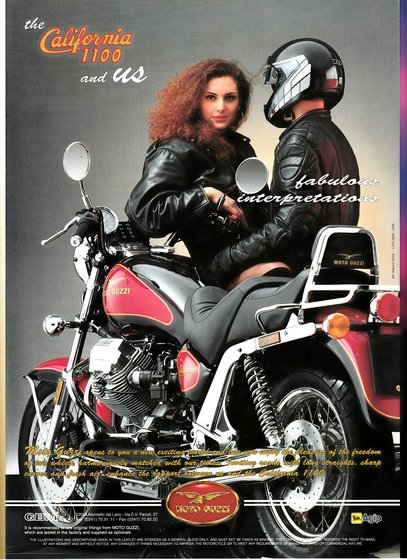
Valve Adjustments & Tuning
The California’s OHV 2-valve engine requires regular valve clearance checks—0.10 mm (0.004 in) for intake and 0.15 mm (0.006 in) for exhaust. Use feeler gauges and a cold engine for accuracy. The Magneti Marelli ignition system is robust, but upgrading to iridium plugs (NGK BPR6EIX) can improve cold starts.
Fluids & Filters
- Engine Oil: 3.0 liters of SAE 20W-50 (change every 5,000 km/3,100 miles).
- Final Drive: 250 ml of SAE 80W-90 gear oil (annually).
- Brakes: DOT 4 fluid flush every two years.
Tires & Suspension
Stick with the stock sizes (110/90-18 front, 140/80-17 rear) for stability. The 40mm forks perform best with 10W–15W oil (70 ml per leg). Adjust rear preload to match your load—stiffen it for two-up touring.
MOTOPARTS.store Recommendations
- Upgrade to sintered brake pads for improved bite.
- Install a aftermarket windscreen or leather saddlebags for touring comfort.
- Replace worn suspension components with adjustable aftermarket shocks.
Conclusion: A Motorcycle That Demands to Be Felt
The Moto Guzzi California 1100 isn’t a bike you simply ride—it’s one you experience. Its vibrations, shaft-drive quirks, and unrefined gearbox are flaws to some, but to enthusiasts, they’re proof of a machine that’s alive. In an age of sterile, computer-perfected motorcycles, the California 1100 remains a raw, emotive artifact—a reminder that riding should engage all the senses.
Whether you’re restoring a 1996 model or upgrading a 2013 finale, MOTOPARTS.store has the components to keep your Guzzi thriving. From period-correct accessories to modern performance upgrades, we’re here to help you write the next chapter in your California’s story.
Specifications sheet
| Engine | |
|---|---|
| Stroke: | Four-stroke |
| Ignition: | Magneti Marelli electronic digital |
| Max power: | 75 kW | 101.0 hp |
| Max torque: | 95 Nm |
| Fuel system: | Weber 40mm fuel injection |
| Max power @: | 6400 rpm |
| Displacement: | 1064 ccm |
| Max torque @: | 5000 rpm |
| Bore x Stroke: | 92.0 x 80.0 mm (3.6 x 3.1 in) |
| Configuration: | V |
| Cooling system: | Air |
| Compression ratio: | 9.5:1 |
| Number of cylinders: | 2 |
| Valves per cylinder: | 2 |
| Dimensions | |
|---|---|
| Wheelbase: | 1560 mm (61.4 in) |
| Dry weight: | 251 |
| Wet weight: | 270 |
| Seat height: | 720–780 mm (28.3–30.7 in) |
| Overall width: | 760 mm (29.9 in) |
| Overall height: | 1150 mm (45.3 in) |
| Overall length: | 2380 mm (93.7 in) |
| Fuel tank capacity: | 19.0 L (5.0 US gal) |
| Drivetrain | |
|---|---|
| Clutch: | Wet, cable-operated |
| Final drive: | shaft |
| Transmission: | 5-speed |
| Maintenance | |
|---|---|
| Engine oil: | 20W50 |
| Brake fluid: | DOT 4 |
| Spark plugs: | NGK BPR6ES or NGK BPR6EIX |
| Forks oil type: | 10W or 15W |
| Spark plug gap: | 0.6 |
| Final drive oil: | 250 ml SAE 80W-90 |
| Forks oil capacity: | 0.14 |
| Engine oil capacity: | 3.0 |
| Valve clearance (intake, cold): | 0.10 mm |
| Valve clearance (exhaust, cold): | 0.15 mm |
| Recommended tire pressure (rear): | 2.5 bar (36 psi) |
| Recommended tire pressure (front): | 2.3 bar (33 psi) |
| Additional Notes | |
|---|---|
| Top speed: | 190 km/h (118 mph) |
| Idle speed: | 1100–1200 RPM |
| Standing ¼ mile: | 13.2 sec / 159.8 km/h |
| Chassis and Suspension | |
|---|---|
| Rear tire: | 140/80-vb17 |
| Front tire: | 110/90-vb18 |
| Rear brakes: | Single 270 mm disc, 2-piston caliper |
| Front brakes: | Dual 300 mm discs, 2-piston calipers |
| Rear suspension: | Twin shocks, adjustable preload and 2-way damping |
| Front suspension: | 40mm telescopic forks, rebound damped |



